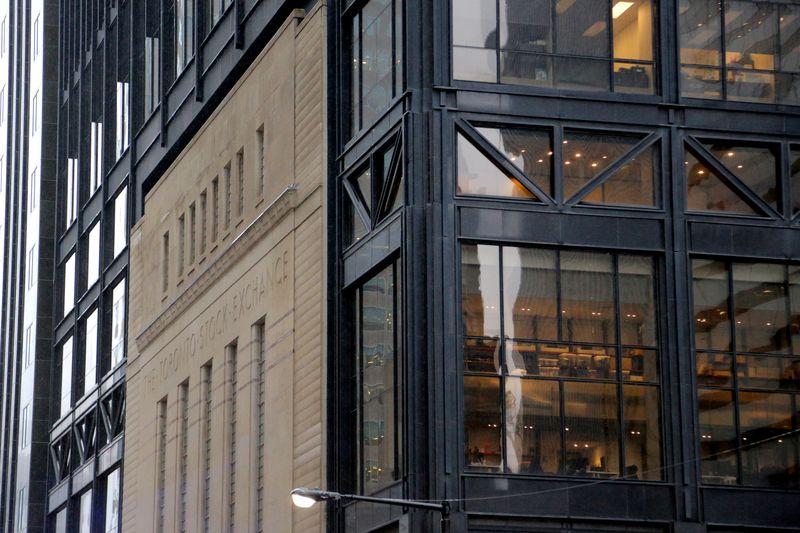Stock market today: S&P 500 falls as job cuts stoke economic fears, tech stutters
Investing.com - Canada’s main stock exchange shed it gains to close lower as U.S. President Donald Trump cancelled trade talks with Canada. The average notched a fresh all-time peak in the prior session.
The S&P/TSX Composite settled 0.22% lower at 26,692.32, paring gains from the record highs logged in previous sessions.
Similarly, the S&P/TSX 60 dropped 2.4 points or 0.15%.
Stocks in Canada and the U.S. were both buoyed by a resilient truce between Israel and Iran, as well as a raft of economic data that appeared to bolster the case for Federal Reserve interest rate reductions later this year.
That was until Trump announced on Truth Social: "We are hereby terminating ALL discussions on Trade with Canada, effective immediately." The President cited a digital services tax that Canada recently introduced to place on U.S. tech companies, calling it a copy of EU policies and a "direct and blatant attack on our Country."
More tariffs are now on their way to Canada, too, with Trump announcing that added levies will be introduced within the next week. The escalation caused a quick drop in Canada stock, but also brought U.S. markets down, as the erratic trade policy of the current U.S. administration reignited cautiousness in investors.
The news comes after Statistics Canada released data showing a 0.1% contraction in Canada’s real GDP in April, which is lower than analyst estimates and a decline from the 0.2% gain in March.
U.S. stocks closed higher
U.S. stocks edged higher, an extension to recent gains with S&P500 touching record high of 6,169.84 surpassing the one touched on February.
At close, the Dow Jones Industrial Average rose 432 points or 1% at 43,819.27, and the S&P 500 gained 28.2 points, or 0.47%. While the NASDAQ Composite came in at 20,273.46 points, gaining 0.52% or 105.55 points.
The main averages on Wall Street advanced in the prior session, all gaining just under 1%, resulting in the Dow Jones Industrial Average and the S&P 500 gaining more than 2% this week, and the NASDAQ Composite rising more than 3%.
Key inflation data due; Fed rate cut bets persist
Sentiment has been boosted by the ongoing truce between Israel and Iran, as well as the U.S. forging an agreement with China over how to expedite the shipment of rare earths materials that are crucial to a range of industries.
Additionally, White House Press Secretary Karoline Leavitt suggested that President Donald Trump could extend his 90-day reciprocal tariff pause beyond a self-imposed deadline early next month, lessening tensions surrounding the Trump’s administration volatile trade policies.
With the easing of geopolitical and trade tensions, attention has mostly turned to the health of the U.S. economy and the response of the Fed.
Data on Thursday showed that U.S. gross domestic product shrank by an annualized 0.5% in the first quarter, the first contraction since 2022.
Meanwhile, the number of Americans filing new applications for jobless benefits fell by 10,000 last week, but the unemployment rate could rise in June as more laid-off people struggle to find work.
Investors now await May’s personal consumption expenditures price index reading, the Fed’s preferred gauge of inflation, due later in the session, and will be studied carefully for clues on when the central bank will next ease monetary policy.
The trajectory of inflation remains one of the major question marks facing Fed policymakers as they decide on the path ahead for interest rates. The central bank has recently adopted a wait-and-see attitude to future policy changes, arguing that they are still waiting to see how Trump’s aggressive tariff agenda is impacting price gains.
Fed Chair Jerome Powell said this week that the central bank needs more time to assess tariff-driven inflation before cutting rates, prompting sharp criticism from President Trump, who demanded immediate rate cuts.
A report from the Wall Street Journal said Trump has toyed with the idea of naming Powell’s replacement as early as September, potentially with someone more dovish on borrowing costs.
Crude down
Crude prices were trading lower, on track for their steepest weekly falls for over two years as the Israel-Iran ceasefire saw traders remove a hefty risk premium from the market.
By midday, Brent futures were down 0.25% to $66.52 a barrel and U.S. West Texas Intermediate crude futures rose 0.08% to $65.22 per barrel.
Both benchmarks are on course for weekly losses of around 12%, heading for their steepest weekly decline since March 2023, and are now back at the levels they were at before the conflict between Israel and Iran began.
Gold dips
Gold prices slipped to a near four-week low as a stable Israel-Iran ceasefire weakened safe-haven demand, while investors awaited the Fed’s preferred inflation gauge for clues on future interest rates.
Spot gold declined 1.54% to $3,276.74 an ounce, lowest since June 2. Gold Futures for August dropped 1.77% to $3,288.60/oz by 12:05 ET.
Bullion was on track to shed over 2% this week, marking its second consecutive weekly loss. It has fallen nearly 6% from its record high level touched in late April.
